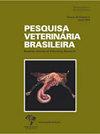亚马逊地区和巴西东南部牛和水牛病毒性腹泻病毒的诊断和系统发育分析
IF 0.8
4区 农林科学
Q3 VETERINARY SCIENCES
引用次数: 0
摘要
摘要:牛病毒性腹泻病毒(Bovine viral diarrhea virus, BVDV)是一种传染性很强的病原体,在世界范围内对牛造成严重的经济影响。尽管巴西拥有世界上最大的商业牛种群和不断增长的水牛养殖业,但该国没有控制或根除BVDV的计划。从这个角度来看,本研究的目的是评估BVDV在巴西两个州的牛和水牛中的发生情况。采用四种不同的酶联免疫吸附试验,并用病毒中和试验(VNT)证实。在6个畜群的77头牛(ELISA-1和ELISA-4)和3个畜群的89头水牛(ELISA-1至ELISA-4)的血清或血浆中检测到BVDV抗体。从血清或血浆样品中提取病毒RNA, RT-PCR检测BVDV。扩增的核苷酸序列用于构建系统发育树。在牛中,ELISA-1检测到49.4%的血清阳性动物,而ELISA-4检测到37.7%。在水牛中,ELISA-1未检测到任何血清阳性动物,而ELISA-2和ELISA-3检测到20.2%的血清阳性动物,ELISA-4检测到21.3%的血清阳性动物。在接受检测的9个畜群中,有8个的动物血清反应呈阳性。牛和水牛的PCR阳性率分别为6.5%和9%。在牛中发现1d亚型,在水牛中发现1d和1f亚型。这是巴西首次报道的1f亚型。缺乏控制和根除计划似乎有利于BVDV在巴西畜群中的传播。此外,还需要改进水牛BVDV的诊断策略。本文章由计算机程序翻译,如有差异,请以英文原文为准。
Diagnosis and phylogenetic analysis of bovine viral diarrhea virus in cattle (Bos taurus) and buffaloes (Bubalus bubalis) from the Amazon region and Southeast Brazil
ABSTRACT: Bovine viral diarrhea virus (BVDV) is a highly infectious pathogen that affects bovines worldwide leading to great economic impact. Although Brazil has the largest commercial cattle population throughout the world and an increasing buffalo breeding industry, the country has no control or eradication program for BVDV. In this perspective, the aim of this study was to evaluate the occurrence of BVDV in cattle and buffaloes from two Brazilian states. Four different ELISA tests were performed and confirmed by virus neutralization testing (VNT). The presence of BVDV antibodies in the serum or plasma from 77 cattle from six herds (ELISA-1 and ELISA-4) and from 89 buffaloes from three herds (ELISA-1 through ELISA-4) was detected. Extraction of viral RNA was performed from the serum or plasma samples for the detection of BVDV by RT-PCR analysis. Amplified nucleotide sequences were used to construct a phylogenetic tree. In cattle, ELISA-1 detected 49.4% of seropositive animals, while ELISA-4 detected 37.7%. In buffaloes, ELISA-1 failed to detect any seropositive animals, while ELISA-2 and ELISA-3 detected 20.2% of seropositive animals, and ELISA-4 detected 21.3%. Eight of the nine herds tested had seropositive animals. The rate of PCR positive animals was 6.5% in cattle and 9% in buffaloes. Subtype 1d was found in cattle, and subtypes 1d and 1f were found in buffaloes. This is the first-time subtype 1f has been reported in Brazil. The absence of a control and eradication program seems to be favoring the spread of BVDV in the Brazilian herds. In addition, the improvement of diagnostic strategies for BVDV in buffaloes are required.
求助全文
通过发布文献求助,成功后即可免费获取论文全文。
去求助
来源期刊

Pesquisa Veterinaria Brasileira
农林科学-兽医学
CiteScore
1.30
自引率
16.70%
发文量
41
审稿时长
9-18 weeks
期刊介绍:
Pesquisa Veterinária Brasileira - Brazilian Journal of Veterinary Research (http://www.pvb.com.br), edited by the Brazilian College of Animal Pathology in partnership with the Brazilian Agricultural Research Organization (Embrapa) and in collaboration with other veterinary scientific associations, publishes original papers on animal diseases and related subjects. Critical review articles should be written in support of original investigation. The editors assume that papers submitted are not being considered for publication in other journals and do not contain material which has already been published. Submitted papers are peer reviewed.
The abbreviated title of Pesquisa Veterinária Brasileira is Pesqui. Vet. Bras.
 求助内容:
求助内容: 应助结果提醒方式:
应助结果提醒方式:


